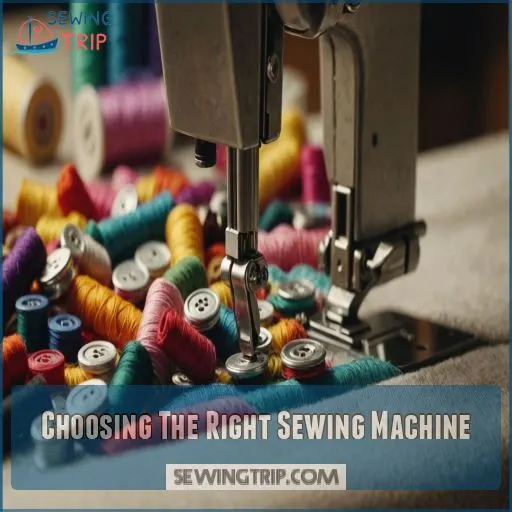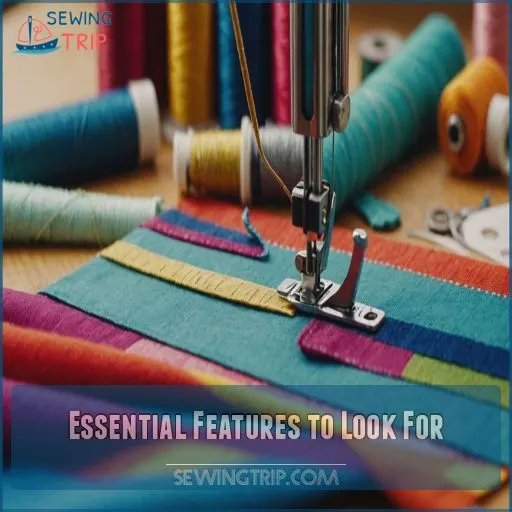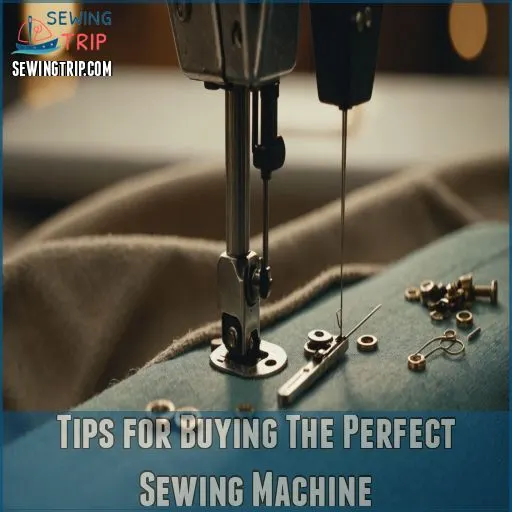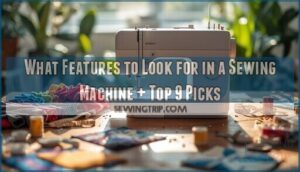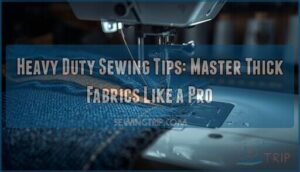This site is supported by our readers. We may earn a commission, at no cost to you, if you purchase through links.
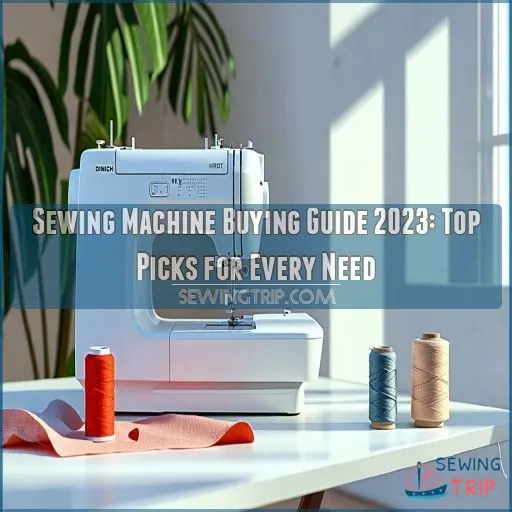
Think about what you’ll sew—cotton shirts or denim jeans?
Beginners usually start with user-friendly mechanical machines, while tech-savvy pros might like computerized ones for fancy stitching.
Look for essential features like an automatic needle threader and built-in cutters to make life easier.
Don’t forget presser feet for versatility!
Before buying, test your options, check repair policies, and hunt for deals like a pro.
Curious about the top models this year? Let’s just say, they’ve got all the bells and whistles.
Table Of Contents
Key Takeaways
- Think about what you’ll sew—light fabrics like cotton or heavy ones like denim—and choose between a mechanical or computerized sewing machine based on your skill level.
- Prioritize features like automatic needle threaders, built-in cutters, and multiple presser feet for versatility and ease of use.
- Test machines before buying to ensure comfort and functionality, and understand the repair policies for long-term satisfaction.
- Keep an eye out for sales and deals, and don’t be shy to negotiate with dealers for the best price.
Choosing The Right Sewing Machine
Choosing the right sewing machine isn’t just about picking a model you like; consider the factors that make a machine great, such as the difference between computerized vs mechanical machines, it’s about matching the machine to your skills and the projects you envision.
With options ranging from basic mechanical models to feature-packed computerized ones, you’ll want to think about your needs and budget to find the perfect fit.
Assessing Your Needs and Skills
Evaluating your sewing needs and skills is essential when choosing a sewing machine, as it helps to consider the types of projects you’ll tackle and your current skill level, such as whether you need a machine for delicate fabrics or heavy-duty quilting. Evaluating your sewing needs and skills is essential when choosing a sewing machine.
Consider your sewing experience and set a budget that fits your future goals and project types.
Reflect on the fabric types you’ll use most.
A clear understanding of these factors will steer you toward a machine with features that match your beginner or advanced needs.
Types of Sewing Machines
Choosing the right sewing machine resembles picking your favorite flavor of ice cream—it depends on taste and needs.
From mechanical to computerized, each type has its own sweet spot.
Mechanical machines are great for beginners, while computerized options offer versatility with stitch types.
For unique stitching, embroidery and heavy-duty machines provide robust performance.
Balance your style and project needs!
Key Features to Consider
After exploring different machine types, focus on important features.
Look for stitch options for creativity, a needle threader to save time, and good speed control for precision.
Consider these must-haves:
- Presser feet: Versatility in handling different fabrics.
- Bobbin type: Ease of use and maintenance.
- Feed dogs: Smooth fabric movement.
These can turn you into a sewing wizard!
Essential Features to Look For
When you’re choosing a sewing machine, focus on essential features like automatic needle threaders and built-in thread cutters to make your sewing life easier.
Don’t overlook the importance of a walking foot and various presser feet.
Plus, check for the right balance of weight and durability to fit your crafting needs.
Automatic Needle Threader
Now that you’ve picked your machine type, consider an automatic needle threader.
It’s a game-changer, saving you time and eye strain.
To make sure you get a reliable one, check out the common troubleshooting steps for automatic needle threader issues.
Look for reliable models with positive reviews—threader reliability is key!
Some machines offer clever alternatives if the automatic threader isn’t for you.
Ignore threader myths; a good one is a true sewing machine accessory.
Remember, mastering your machine means choosing features that empower you.
Built-in Thread Cutter
Imagine not having to fumble around for scissors mid-project.
A built-in thread cutter saves time and creates cleaner finishes, cutting both top and bobbin threads with precision.
But, like a trusty sidekick, maintenance is key.
Opt for machines like the Singer 9960, known for its reliability.
Keep in mind, quality trimmers prevent thread jams and keep sewing flowing smoothly.
Walking Foot
A walking foot is your trusty sidekick for tackling tricky fabrics.
It guarantees even feeding with its own feed dogs, preventing pesky puckers and shifting.
Ideal for quilting, sewing stretchy knits, or aligning plaids, it’s a game-changer for smooth stitching.
Consider it the best walking foot for your creative projects, especially if you’re a sewing machine beginner (Source).
Presser Feet
Stitch a path from using a walking foot to embracing the versatility of presser feet.
The right presser foot types can transform your sewing machine into a multitasking wizard.
Look for a compatible, essential set: zipper, buttonhole, and overlock feet.
Store these wisely, and you’ll open up a world of possibilities in your sewing while quilting heavy-duty fabrics without batting an eye (Source).
Weight and Durability
When choosing a sewing machine, consider its weight and durability.
A lightweight model enhances portability but may compromise durability, especially with heavy fabric.
Look for a sturdy machine frame to handle demanding projects.
When shopping for a sewing machine, consider the essential features of budget-friendly options, such as stitch options and versatility, which can be found in reviews of the best cheap sewing machines reviewed. Heavy-duty sewing machines offer the best value for durability.
Popular sewing machine brands provide options that balance portability and strength, ensuring reliable performance over time (Source).
Top 3 Sewing Machines for 2023
If you’re on a quest to find the best sewing machine for the year, consider the Brother CS7000X, the Janome Horizon Memory Craft 9850, and the SINGER Quantum Stylist 9960.
These top contenders blend cutting-edge technology with user-friendly features,
making your sewing projects both efficient and enjoyable.
1. Brother CS7000X Sewing and Quilting Machine
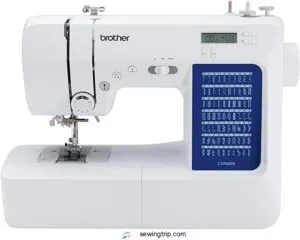
The Brother CS7000X Sewing and Quilting Machine is your trusty sidekick in crafting adventures.
With 70 built-in stitches and an automatic needle threader, you’re ready for anything from basic mending to decorative quilting.
Its drop-in bobbin system isn’t just easy; it’s a no-brainer for smooth stitching.
Toss in the wide table for big projects and a hard case for travel, and you’ve got yourself a powerhouse.
It’s like having an all-in-one fabric wizard on call.
Best For: The Brother CS7000X is best for beginners and experienced sewers who want a versatile machine for a variety of projects.
- Easy to use with features like an LCD display and automatic needle threader
- Offers a wide range of stitches for various sewing and quilting projects
- Includes many accessories and is considered a great value for the price
- Some users may prefer brighter lighting than the LED lights provided
- Using good quality thread and checking the needle’s sharpness can help prevent thread and tension issues
- Designed for 120 volts (US only)
2. Janome Horizon Memory Craft 9850 Sewing Machine
Someone looking for a powerful machine should consider the Janome Horizon Memory Craft 9850.
This combo machine excels at both sewing and embroidery, boasting 200 built-in stitches and 175 embroidery designs.
You’ll appreciate its 9mm stitch width and intuitive touchscreen.
Its impressive features include automatic thread tension and a built-in needle threader, saving you time and frustration.
While it’s a bit heavy, the extra-high presser foot lift makes maneuvering thick fabrics easier.
Remember to check for compatible accessories, mostly Janome brand.
Happy sewing!
Best For: The Janome Horizon Memory Craft 9850 is best for experienced sewers looking for a powerful machine that can handle both sewing and embroidery.
- Versatile combo machine for both sewing and embroidery.
- Impressive features like automatic thread tension and a built-in needle threader.
- Extra-high presser foot lift makes maneuvering thick fabrics easier.
- Heavy and bulky.
- Designed for intermediate to experienced sewers.
- Additional accessories usually have to be Janome brand.
3. SINGER Quantum Stylist 9960 Sewing Machine
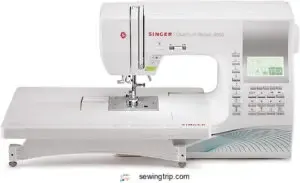
With the Singer 9960 review showcasing its powerful features, including 600 built-in stitches and an automatic thread cutter Learn more about the Singer 9960 Quantum Stylist, the Singer 9960 Quantum Stylist, you’ve got a sewing machine with a versatile and durable design at your fingertips.
This machine offers 1,172 stitch applications, ideal for quilting, embroidery, and beyond.
Its automatic needle threader saves eye strain, while the top drop-in bobbin keeps things hassle-free.
Speed demon? No problem—this machine tops out at 850 stitches per minute.
Enjoy added bonuses like the large extension table and a suite of presser feet for every project.
Whether beginner or pro, you’ll stitch with confidence and flair.
Best For: The SINGER Quantum Stylist 9960 is best for quilters, embroiderers, and seamstresses looking for a versatile machine with a wide range of stitch options.
- Offers a massive 1,172 stitch applications, including alphanumeric fonts and buttonholes, for creative freedom.
- Includes a convenient automatic needle threader, a top drop-in bobbin, and a large extension table for ease of use.
- Boasts a high sewing speed of 850 stitches per minute for efficient stitching.
- The thread cutter has been reported to be unreliable by some users.
- The machine is no longer manufactured, so availability may be limited.
- The price point may be higher than some beginner sewing machines.
Tips for Buying The Perfect Sewing Machine
Finding the perfect sewing machine is a bit like choosing the ideal pair of socks; with some guidance and a few straightforward tips, you can make a confident purchase.
Consider trying out machines before buying.
Understand repair policies.
Remember that sales can be your best friend.
Trying Before You Buy
Exploring those top sewing machine picks is thrilling, but considering the essential features for quilting machines, such as wide throat space for quilting, is crucial to your sewing experience, but how will it feel in your hands?
Test it at local sewing machine shops during Demo Days.
You’ll gain:
- Real-time machine comparison
- Hands-on sewing machine tutorials
- Access to expert sewing machine advice can help you navigate the various types of sewing machines, such as mechanical, electronic, computerized, manual, and serger machines, which cater to different sewing needs and levels of expertise Learn More Here. Access to expert sewing machine advice
- Trial periods for peace of mind
Get ready to sew with confidence!
Checking Repair Policies
Trying a machine is fun, but understanding repair policies is key to long-term satisfaction.
Check warranty coverage and know your repair costs upfront, such as those offered by Brother’s standard 12 to 36 months warranty coverage Brother sewing machine warranties.
Ask about authorized service centers and local technicians.
Familiarize yourself with your sewing machine manual and consider the type of stitching you’ll be doing most often, such as the best sewing machine for your budget, for troubleshooting tips, maintenance suggestions, and care instructions.
This buying guide helps your machine run smoothly and economically.
Negotiating With Dealers
When contemplating repair policies, think about negotiating with dealers.
A sewing machine’s price isn’t set in stone, and building dealer relationships can yield perks.
Consider these tips:
- Mention online prices.
- Ask about warranty details.
- Discuss trade-ins and financing options.
- Highlight models like best heavy duty.
Remember, it’s like haggling for a car!
Seeking Out Sales
Hunting for a good sewing machine deal?
Keep your eyes peeled for seasonal sales, like Black Friday or back-to-school events, for the best sale timing.
Compare online vs. in-store options.
Sign up for sale alerts and grab coupon codes to stretch your dollars further.
Look into budget-friendly brands, and stay informed about trends and innovations in the sewing machine market.
Frequently Asked Questions (FAQs)
Which sewing machine has the least problems?
Imagine stumbling upon the Janome Memory Craft 9450 QCP.
It’s like a sewing machine superhero with its minimal issues and superb reliability.
Ideal for quilting, its 11" throat space keeps you gliding along effortlessly.
How much should you pay for a good sewing machine?
Pay between $200 and $750 for a good sewing machine, depending on your needs and budget.
Opt for durability and features like automatic tension control or sturdy construction, ensuring you get your money’s worth and sewing satisfaction.
What factors should you consider when choosing a sewing machine?
Choosing a sewing machine involves understanding your sewing needs, budget, and desired features.
Consider the types of projects you want, the machine’s durability, ease of use, and adaptability for skill growth.
Remember, quality machines enhance creativity.
What is the most dependable sewing machine?
The Brother CS7000X stands out as a dependable sewing machine.
It offers computerized features, a reasonable price, and excellent performance.
Perfect for sewing various fabrics, it’s ideal for those who desire a reliable companion in crafting.
What types of fabric can I sew with it?
A stitch in time saves nine! You’ll master various fabrics; from delicate silks to sturdy denim, even challenging leather, with the right needle and settings. Experiment and enjoy the process!
How do I maintain and clean my machine?
Unplug your machine, remove the thread, then using a lint brush, clean around the bobbin and shuttle area.
Regularly change the needle and oil moving parts.
Remember, a clean machine sews like a dream.
Are there eco-friendly models available?
Like a gentle stitch in the fabric of eco-conscious living, the Husqvarna Viking Tribute 150C stands out.
It’s energy-efficient, crafted with durable components, and comes with green projects.
Perfect for those passionate about sustainable sewing.
How noisy is the sewing machine during use?
When choosing a sewing machine, noise levels vary.
Some models, like the Singer Heavy Duty 4423, are relatively quiet.
Others, especially sergers, can be loud enough to disturb your peace and quiet while sewing.
Can it handle quilting projects as well?
Imagine stitching those vibrant quilt layers effortlessly.
Your 2023 sewing machine is up to the task, equipped with features like a walking foot and adjustable stitches, ensuring precision and ease.
Quilting projects are a breeze!
Conclusion
Picture yourself crafting garments with ease, your sewing space transformed into a haven of creativity, all thanks to the perfect pick from this sewing machine buying guide 2023.
Whether you’re a novice happy with the basics or a seasoned pro chasing precision, there’s a machine suited for you.
Explore features like automatic threaders and presser feet!
So, armed with the right advice, go forth and make that dream project a reality.
Happy sewing!

